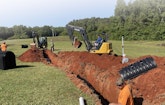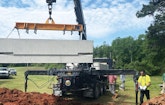
The first trench is filled with Infiltrator chambers, while workers dig the second and third trenches in series. (Photos courtesy of Geiger’s Septic Services)
Each year, the Alabama Onsite Wastewater Association picks several projects as part of its Helping Hands Across Alabama to donate new septic systems. One of the recipients in 2022 is the Exodus Ranch, a charitable organization that houses at-risk children.
Marc Geiger, owner of...









